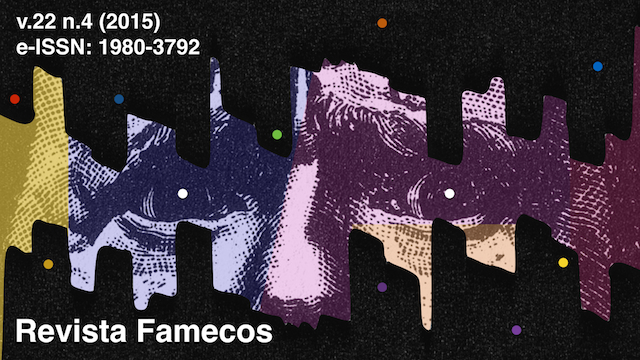Repensando el desplazamiento de la media: las tensiones entre las medias móviles y la interacción cara a cara
DOI:
https://doi.org/10.15448/1980-3729.2015.4.21005Palabras clave:
Phubbing, Desplazamiento de la media, Medias móvilesResumen
El neologismo phubbing, mezcla de palabras que remiten a las actividades mediadas por el teléfono y efectos de desprecio, ofrece imperativos para acentuar la percepción ubicua de ser aborrecido, ignorado y ofendido en razón de un dispositivo móvil presente en situaciones de interacción personal. Su sintomático registro acompaña importantes descubrimientos sobre la difusión de medias móviles en países en desarrollo, en los cuales los jóvenes son los grupos sociales más activos en este escenario. Incorporando y relacionando la teoría del desplazamiento de la media, nos enfocamos en el análisis de un cuestionario sobre jóvenes brasileños y chinos, identificando cómo comprenden y lidian con las tensiones entre las medias móviles y la interacción cara a cara. Los resultados pueden contribuir con nuevos matices a la discusión sobre el desplazamiento de la media.
Descargas
Citas
AUTER, P. J. Portable social groups: willingness to communicate, interpersonal communication gratifications, and cell phone use among young adults. International Journal of Mobile Communications, v.5, n. 2, p. 139-156, 2007.
AUXILIADORA DESSEN, M.; TORRES, C. V. Family and socialization factors in Brazil: An overview. Online readings in psychology and culture, v. 6, n. 3, 2002.
BAYM, N. K. Personal connections in the digital age. Polity, 2010.
BIAN, Y. . Bringing strong ties back in: Indirect ties, network bridges, and job searches in China. American sociological review, 1997. p. 366-385.
CAMPBELL, S. W.; RUSSO, T. C. The cocial construction of mobile telephony: an application of the social influence model to perceptions and uses of mobile phones within personal communication networks. Communication Monographs, v. 70, n.
, p. 317-334, 2003.
CNNIC. Research Report on Mobile Internet in China. 2014. Retrieved from: http://www.cnnic.cn/hlwfzyj/hlwxzbg/ydhlwbg/201408/P020140826360212699278.pdf Accessed in: mar. 2015.
DIMMICK, J.; CHEN, Y., & Li, Z. Competition between the Internet and traditional news media: The gratification-opportunities niche dimension. The Journal of Media Economics, v. 17, n. 1, 19-33, 2004.
FUNDAÇÃO TELEFONICA. Juventude Conectada. Agência de Conteúdo. 2014.
GARDNER, H.; DAVIS, K. The App generation: How today's youth navigate identity, intimacy, and imagination in a digital world. Yale University Press, 2013.
GERGEN, K. J. The challenge of absent presence. In: KATZ, J. E.; AAKHUS, M. (Eds.)., Perpetual contact: Mobile communication, private talk, public performance. Cambridge University Press, 2002.
GLOBO. Apaixonados por tecnologia ficam 48h sem celulares em 'praia detox'. 2015. Retrieved from: http://g1.globo.com/fantastico/noticia/2015/05/apaixonados-por-tecnologia-ficam-48h-sem-celulares-em-praia-detox.html. Accessed in: Mar. 2015.
GOLUB, A.; LINGLEY, K. Just Like the Qing Empire Internet Addiction, MMOGs, and Moral Crisis in Contemporary China. Games and Culture, v. 3, n. 1, p. 59-75, 2008.
GOFFMAN, E. Behavior in public places. Simon and Schuster. 2008.
HWANG, Y. Is communication competence still good for interpersonal media?: Mobile phone and instant messenger. Computers in Human Behavior, v. 27, n. 2, p. 924-934, 2011.
LENHART, A.; LING, R.; CAMPBELL, S.; PURCELL, K. Teens and Mobile Phones. Pew Research. 2010. Retrieved from: http://www.pewinternet.org/files/old-media//Files/Reports/2010/PIP-Teens-and-Mobile-2010-with-topline.pdf. Accessed in: Mar, 2015.
ISHII, K. Implications of mobility: The uses of personal communication media in everyday life. Journal of Communication, v. 56, n. 2, p. 346-365, 2006.
KAYANY, J. M.; YELSMA, P.. Displacement effects of online media in the socio-technical contexts of households. Journal of Broadcasting & Electronic Media, v. 44, n. 2, p. 215-229, 2000.
LAZARSFELD, P. F. Radio and the printed page. New York: Dell, Sloan and Pearce, 1940.
_____. BERELSON, B.; GAUDET, H. The People’s Choice. New York: Columbia University Press, 1948.
LING, R. New tech, new ties. Cambridge, MA: Mit Press, 2008.
_____. Children, youth, and mobile communication. Journal of Children and Media, v. 1, n. 1, p. 60-67, 2007.
NEWELL, J.; PILOTTA, J. J.; THOMAS, J. C. Mass media displacement and saturation. The International Journal on Media Management, v. 10, n. 4, p. 131-138, 2008.
PEOPLE.CN. What brings forth more and more “look down clan”? 2013. Retrieved from: http://opinion.people.com.cn/GB/363551/369083/index.html
PETERS, O.; BEN ALLOUCH. Always connected: a longitudinal field study of mobile communication. Telematics and Informatics, v. 22, n. 3, p. 239-256, 2005.
PETRIC, G., PETROVICIC, A.; VEHOVAR, V. Social uses of interpersonal communication technologies in a complex media environment. European Journal of Communication, v. 26, n. 2, p. 116-132, 2011.
PIERCE, T. Social anxiety and technology: Face-to-face communication versus technological communication among teens. Computers in Human Behavior, v. 25, n. 6, p. 1367-1372, 2009.
PRZYBYLSKI, A. K.; WEINSTEIN, N.. Can you connect with me now? How the presence of mobile communication technology influences face-to-face conversation quality. Journal of Social and Personal Relationships, v. 30, n. 3, p. 237-246, 2012.
QIU, J. L.. Working-class network society: Communication technology and the information have-less in urban China. MIT Press, 2009.
REID, D. J.; REID, F. J. Text or talk? Social anxiety, loneliness, and divergent preferences for cell phone use. CyberPsychology & Behavior, v. 10, n. 3, p. 424-435, 2007.
STROVER, S. A Retrospective on Convergence, Moral Panic, and the Internet. In Francis L. F. Lee, Louis Leung, Jack L. Qiu, & Donna S. C. Chu (Eds). Frontiers in new media research. Routledge, 2013. p. 132-154.
STALD, G. Mobile identity: Youth, identity, and mobile communication media. Youth, identity, and digital media, 2008. p. 143-164.
THOMPSON, K.. Moral panics. Routledge, 2013.
TURKLE, S. Alone together: Why we expect more from technology and less from each other. Basic books. 2012.
_____. Always-on/always-on-you: The tethered self. In: KATZ, J. E. (Ed). Handbook of Mobile Communication and Social Change. Cambridge, MA: MIT Press, 2006.
VAN CLEEMPUT. Friendship type, clique formation and the everyday use of communication technologies in a peer group: A social network analysis. Information, Communication & Society, v. 15, n. 8, p. 1258-1277, 2012.
YU, L.; TNG, T. H. Culture and design for mobile phones for China. In: KATZ, J. E. (Ed.). Machines that become us: The social context of personal communication technology. Transaction Publishers, p. 187-198, 2003.
YUAN, E. J. From “perpetual contact” to contextualized mobility: Mobile phones for social relations in chinese society. Journal of International and Intercultural Communication, v. 5, n. 3, p. 208-225, 2012.
Zhang, Q. Family communication patterns and conflict styles in Chinese parent-child relationships. Communication Quarterly, v. 55, n. 1, p. 113-128, 2007.
Descargas
Publicado
Cómo citar
Número
Sección
Licencia
Derechos de Autor
La sumisión de originales para la Revista Famecos implica la transferencia, por los autores, de los derechos de publicación. El copyright de los artículos de esta revista es el autor, junto con los derechos de la revista a la primera publicación. Los autores sólo podrán utilizar los mismos resultados en otras publicaciones indicando claramente a Revista Famecos como el medio de la publicación original.
Creative Commons License
Excepto donde especificado de modo diferente, se aplican a la materia publicada en este periódico los términos de una licencia Creative Commons Atribución 4.0 Internacional, que permite el uso irrestricto, la distribución y la reproducción en cualquier medio siempre y cuando la publicación original sea correctamente citada.






